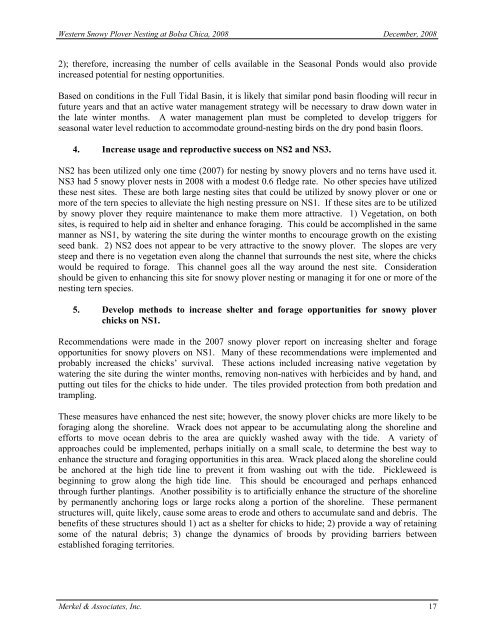2008 Annual Monitoring Report (pdf 10.9MB) - Bolsa Chica ...
2008 Annual Monitoring Report (pdf 10.9MB) - Bolsa Chica ...
2008 Annual Monitoring Report (pdf 10.9MB) - Bolsa Chica ...
You also want an ePaper? Increase the reach of your titles
YUMPU automatically turns print PDFs into web optimized ePapers that Google loves.
Western Snowy Plover Nesting at <strong>Bolsa</strong> <strong>Chica</strong>, <strong>2008</strong> December, <strong>2008</strong><br />
2); therefore, increasing the number of cells available in the Seasonal Ponds would also provide<br />
increased potential for nesting opportunities.<br />
Based on conditions in the Full Tidal Basin, it is likely that similar pond basin flooding will recur in<br />
future years and that an active water management strategy will be necessary to draw down water in<br />
the late winter months. A water management plan must be completed to develop triggers for<br />
seasonal water level reduction to accommodate ground-nesting birds on the dry pond basin floors.<br />
4. Increase usage and reproductive success on NS2 and NS3.<br />
NS2 has been utilized only one time (2007) for nesting by snowy plovers and no terns have used it.<br />
NS3 had 5 snowy plover nests in <strong>2008</strong> with a modest 0.6 fledge rate. No other species have utilized<br />
these nest sites. These are both large nesting sites that could be utilized by snowy plover or one or<br />
more of the tern species to alleviate the high nesting pressure on NS1. If these sites are to be utilized<br />
by snowy plover they require maintenance to make them more attractive. 1) Vegetation, on both<br />
sites, is required to help aid in shelter and enhance foraging. This could be accomplished in the same<br />
manner as NS1, by watering the site during the winter months to encourage growth on the existing<br />
seed bank. 2) NS2 does not appear to be very attractive to the snowy plover. The slopes are very<br />
steep and there is no vegetation even along the channel that surrounds the nest site, where the chicks<br />
would be required to forage. This channel goes all the way around the nest site. Consideration<br />
should be given to enhancing this site for snowy plover nesting or managing it for one or more of the<br />
nesting tern species.<br />
5. Develop methods to increase shelter and forage opportunities for snowy plover<br />
chicks on NS1.<br />
Recommendations were made in the 2007 snowy plover report on increasing shelter and forage<br />
opportunities for snowy plovers on NS1. Many of these recommendations were implemented and<br />
probably increased the chicks’ survival. These actions included increasing native vegetation by<br />
watering the site during the winter months, removing non-natives with herbicides and by hand, and<br />
putting out tiles for the chicks to hide under. The tiles provided protection from both predation and<br />
trampling.<br />
These measures have enhanced the nest site; however, the snowy plover chicks are more likely to be<br />
foraging along the shoreline. Wrack does not appear to be accumulating along the shoreline and<br />
efforts to move ocean debris to the area are quickly washed away with the tide. A variety of<br />
approaches could be implemented, perhaps initially on a small scale, to determine the best way to<br />
enhance the structure and foraging opportunities in this area. Wrack placed along the shoreline could<br />
be anchored at the high tide line to prevent it from washing out with the tide. Pickleweed is<br />
beginning to grow along the high tide line. This should be encouraged and perhaps enhanced<br />
through further plantings. Another possibility is to artificially enhance the structure of the shoreline<br />
by permanently anchoring logs or large rocks along a portion of the shoreline. These permanent<br />
structures will, quite likely, cause some areas to erode and others to accumulate sand and debris. The<br />
benefits of these structures should 1) act as a shelter for chicks to hide; 2) provide a way of retaining<br />
some of the natural debris; 3) change the dynamics of broods by providing barriers between<br />
established foraging territories.<br />
Merkel & Associates, Inc. 17






